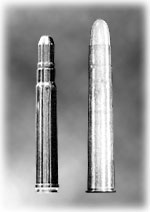 |
| Left: .375 H&H Right: .470. |
Harry Manners and Wally Johnson began elephant hunting in partnership in Mozambique in 1937, and both used off-the-shelf Winchesters (Harry owned four during his lifetime, one of which having a ‘bull-barrel’, which he discarded on the grounds of it being too heavy), both used only Kynoch 300-grain solids, and both averred that this rifle/cartridge combination was all that any professional ivory hunter ever needed. They were both expert shots and could place their bullets accurately from any angle for brain-shots on elephant, but both used shoulder shots when these were convenient, alleging that this was the largest and safest target. Harry shot The Monarch of Murrapa (185 and 183 pounds a side and number four in Rowland Ward’s Records of Big Game) with a single 300-grain .375 solid in the shoulder (the full story of this hunt being told in Harry’s autobiography, Kambaku, recently republished by Rowland Ward Publication, Johannesburg).
When ivory hunting was stopped in Mozambique in the early 1950s in favour of safari hunting, Harry and Wally entered the safari field, both still only using their .375s, and I first got to know them when visiting Moçambique Safarilandia’s Savé concessions at the owner’s invitation in 1965. Harry retired unscathed to Skuzuza in Kruger National Park after Mozambique’s independence, where I often visited him, while Wally, who had earlier been gored by a buffalo his .375 failed to stop, joined Safari South in Botswana, for whom I also hunted and where we renewed our friendship. In spite of Wally’s mishap with the buffalo, both he and Harry went to their graves asserting that a .375 H&H Magnum with 300-grain solid bullets was all a professional hunter needed for the hunting of elephant.
Two very experienced Zimbabwean game wardens who only ever used a .375 were John Osborne and Bruce Austen, and both agreed that it was completely adequate for elephant and both shot large numbers of elephant with their .375s, although Bruce told me he had once all-but-lost a bull wounded with his .375 that he was convinced did not have a brain.
His first shot to the brain was taken from close range with the bull standing squarely side-on, but on receiving Bruce’s 300-grain solid, the bull had merely spun around to stand again squarely side-on, whereupon Bruce gave him another similarly placed bullet on the other side of his head. Both these shots were in Bruce’s experienced opinion ‘correctly placed for the brain’, yet the bull took off and was stopped only by a raking shot to the body that Bruce was able to take before it disappeared.
I was very inexperienced when Bruce told me this story and I fervently hoped that I didn’t run up against too many brainless elephant, but I had the odd few even with my .470. The best designed bullet will sometimes deflect on striking bone - particularly when fired from close range before it has had time to stabilize - and Kynoch’s round-nose 300-grain .375 solid bullet is very well designed. But the fact that both of Bruce’s bullets failed to find the brain from the same range and angle might indicate that they had both deflected for the same reason.
We are all influenced by the advice of our mentors and if what they advise works the first time we are prone to become persuaded. My mentor was John ‘Pondoro’ Taylor whom I knew in the mid-1950s while commercial crocodile hunting on Lake Nyasa (now Lake Malawi), and I visited him whenever I was able and was always asking questions. Those who have read his Big Game and Big Game Rifles, or African Rifles & Cartridges, will know that Taylor was a disciple of the ‘heavy, medium-velocity’ school, and I faithfully followed. Like Tayor, I became a ‘doubles man’ and opted for a .470 double (a 500-grain bullet at 2150fps) when in the early 1960s I was granted the game management rights on the half-million acre Nuanetsi ranch in Rhodesia’s south-eastern lowveld, and had large quotas of elephant to cull.
John Osborne and Bruce Austen both left 'Parks to become safari professional hunters, Bruce running his own company and John hunting for Buffalo Range game ranch which is owned by the Style family, my wife’s cousins. The fifth professional hunter whom I know who has exclusively used a .375 H&H Mag as his safari back-up rifle is Rob Style of Buffalo Range, who for many years has had big-game concessions in the Zambezi Valley and whose clients have taken a great many elephant. Rob’s mentor was John Osborne, and Rob received the best elephant hunting training that anyone could have had and was a highly experienced hunter when he became a licenced professional at the age of 19. Rob followed John’s example in opting for a .375 as I had followed Taylor’s in opting for a .470. Rob had a minor tussle with a wounded lion on one occasion which his .375 had failed to stop, but has never had a serious problem with an elephant, which begs the question: Is there any more that I need to say?
|